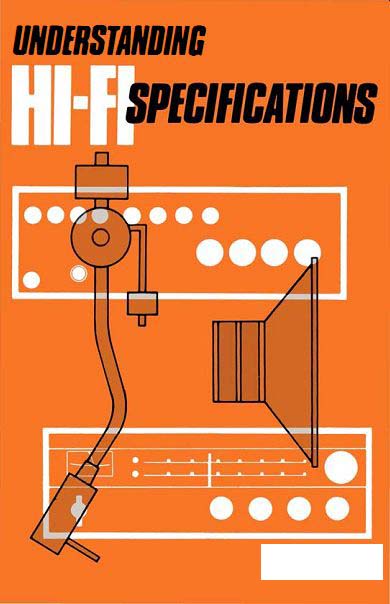Contents of this Guide:
1. WHAT IS A SPECIFICATION? -- Parameters. Customer's viewpoint. Hi-fi specifications. Hi-fi amplifier. Tuner. Loudspeakers. Headphone sets. Tape machines. Record decks. FM aerial. Parameter accuracy.
2. AMPLIFIER SPECIFICATIONS -- Example specification. Power output. Load values. Current limiting. Frequency range. Amplifier/Loudspeaker interface. Power factor. Distortion. Power bandwidth. Frequency response. Half-power point. Filters and tone controls. Loudness. Damping factor. S/N ratio. Residual hum and noise. Input sensitivity and impedance. Pickup overload. Tape recording output. Other parameters.
3. TUNER SPECIFICATIONS -- Example specification. Sensitivity. Limiting. 3rd-order IMD. Front end selectivity. Repeat spot suppression. I.F. and image response rejection. Capture ratio. Selectivity. S/N ratio. Noise weighting. CCIR/ ARM characteristic. A.M. rejection. Hum. Pilot tone rejection. Distortion. Frequency response. Stereo separation. Distortion on breakthrough signal. Birdies suppression.
4. TAPE MACHINE SPECIFICATIONS -- Parameters. Example specification. Input sensitivity and overload. Output level and overload. VU meter. Harmonic and intermodulation distortion. Head amplifier/head overload threshold. S/N ratio. Dynamic range. Frequency response. Wow and flutter. Spooling time. Stereo separation. Tape types.
5. TURNTABLE SPECIFICATIONS-- Example specification. Turntable parameters. Arm parameters. Cartridge parameters. Interface problems. Tracking and mistracking.
6. LOUDSPEAKER SPECIFICATIONS -- Example specification. Operating principle. Drive units. Power handling. Impedance. Phase angle. Impedance change. Input power. Frequency response. Distortion. Amplifier power requirement.
7 SPECIFICATIONS OF ANCILLARY EQUIPMENT & INTERFACING -- Hi-fi receiver. Output/input matching. Matrix decoder. Tape circuit interface. Control and power amplifier units. Transient IMD. Aerials for FM Feeders and aerial parameters. Headphones and their parameters.
8. DO BETTER SPECS LEAD TO BETTER SOUND? -- Orchestra sound. Comparative audition. 'Specmanship'. Opinionated approach. E.S.P. Specs don't tell all. Effect of interfaces. Effect of acoustics. Listening tests. Parameters which influence listening. Pickup overload margin. Distortion distribution. Tuner de-emphasis. Stereo separation.

PREFACE
This GUIDE, adapted from a 1978 book, is styled to complement the ever-growing series of guides on hi-fi subjects in our Gamma Electronics website . It brings together all the major specifications of hi-fi equipment and separately investigates each parameter.
The plan has been to interpret the parameters in the least technical manner possible, to help towards an understanding of their meanings, to help with the choice of hi-fi equipment from manufacturers' specifications and from the tested parameters in hi-fi magazine reviews and to see how different makes and designs of hi-fi equipment compare technically relative to purchase price.
It is known that undue simplification can seriously detract from the value of a guide owing to technical ambiguity. We have been on guard to avoid this.
Although not a textbook in the true sense of the word, it is directed as an authoritative 'text' to the hi-fi enthusiast , hi-fi dealer and his staff and to the student of matters hi-fi. The level (it is hoped!) is set so as not to insult the technical sensibility of our readership, and to this end we have avoided kindergarten colloquialisms.
We have found from our wide contacts with hi-fi people - both technical and not so technical -- that nursery language is not only insulting to them but also that it fails to lead to a proper understanding of the principles involved.
Although sometimes regarded as an art - and, more recently, as something of a 'witchcraft' -- hi-fi is also an intrinsically exacting science which, for its full appreciation, must be treated as such. It is certainly not outside the ken of the average chap in the street to appreciate, if not fully to understand.
A good deal of the information presented in this guide has been researched in the labs of Gordon J. King (Enterprises) Limited, to whom full acknowledgement is given, and a number of the parameters looked at reflect latter-day thinking and measuring techniques.
You will note in Section 8 that we fail to subscribe to the passing school of thought which belittles physical measurements and, particularly, that which places undue emphasis on solitary 'opinion' of a listener as the primary judgment of reproduction quality.
It is our considered judgment that if any item of hi-fi equipment is conclusively proved to be relatively 'poor' or relatively 'good' during audition, then there are immutable physical laws responsible, which must obviously be objectively detectable (by instrument tests). The excellent article by John Gardner, entitled Gizmology, and published on page 60 of Practical Hi-Fi and Audio of September, 1977 exposes some interesting points in this respect, and is well worth reading, even if it means going to the local library to seek out the copy! We are certainly not opposed to listening tests to supplement lab measurements; but these must be as well controlled and as scientific as the lab measurements themselves. Indeed, a full assessment of hi-fi equipment demands auditioning. Our lab has available a long-standing listening panel of ten to twelve people, all of whom have been 'weighted' and tested, with a large proportion concert goers on a regular basis or in other ways directly connected with live music.
Sound is rather like color -- not all people discern it the same way. Hence the danger of relying solely upon 'personal opinion' and the adjectives - sometimes invented ones - to describe this. Parameter measurements will always be essential for a proper evaluation of hi-fi equipment. The pinnacle, of course, is to seek out those measurements which have the greatest correlation with the listening experience, and this is just what has been happening in our lab over the last several years in conjunction with our listening panel.
Also see:
Ultimate Guide to Digital Audio
= = = =